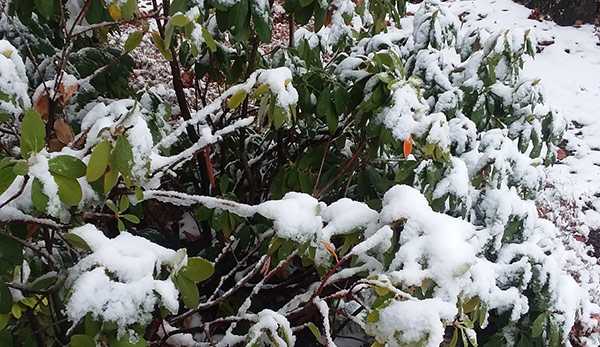
Protecting Your Garden from Cold Weather
Cold weather can be a silent enemy to your garden, often causing unseen damage to plants, trees, and shrubs. Many gardeners overlook this issue, only to find signs of harm in the spring. Wilting leaves and a sparse canopy might surprise you in an otherwise lush season, and you may notice defoliation weeks after a brief cold spell. The root cause? Water management within the plant.
Snow on Your Trees and Shrubs
Should you worry about heavy snow on trees and shrubs?
After a heavy snowfall, have you ever thought about removing heavy snow from the branches of your trees and shrubs? There are two thoughts about this question. We will discuss both of them here.

When to Prune Your Spring Shrubs
When Do I Prune Spring Shrubs?
Why Prune?
Pruning is the selective removal of specific plant parts for the benefit of the whole plant. Some reasons to prune are to train a plant, maintain plant health, improve the quality of flowers, fruits, and stems, restrict growth, remove damaged and diseased branches, and to increase air circulation that can decrease specific plant diseases
Tree & Shrub Issues in the Summer
What are Common Tree & Shrub Issues in the Summer?
In Virginia, we often notice several common issues involving your plant material during the summer. In most cases, these issues are already present but become more prevalent during the summer due to heat stress. In the image below, you’ll see lace bug damage on the underside of plant leaf. Lace bugs are very small insects, measuring only about 1/8 inch long, however they can cause considerable damage to the foliage of ornamental shrubs and trees.
Pruning Season
When Should I Prune Trees and Shrubs?
While you can generally prune dead, diseased, or damaged branches year-round, it’s important to prune at timely intervals to create healthy blooms in Trees and Shrubs. Pruning cuts should be made with a sharp pruning tool that’s appropriate for the job and should be limited to no more than roughly 25% of the tree canopy.
Proper pruning paired with Virginia Green’s Premium Tree and Shrub Program will help to provide you with healthy plants in your yard and keep them looking good year round.
How to Identify Scale on Plants
How Can I Identify Scale on Plants and What to Do About Them?
It can be tricky to identify scale as the cause of your plant’s deterioration because there is generally no movement throughout a scale insect’s life cycle. If you suspect scale, the best thing to look for is unusual bumpy growth on the stems and undersides of the leaves. Brown shell-like scale can indicate an infestation. You might also see evidence of a sticky substance called honeydew or sooty mold. Ants might also appear on these plants as they are attracted to the honeydew.
Pruning Boxwoods
How to Prune Boxwoods
Boxwoods are beautiful shrubs which can enhance and beautify your landscape. Often used as a hedge, they can form a screen against unsightly views. Like most shrubs, boxwoods need dead or crossed branches cleaned out and removed, as they can restrict healthy growth.
Newly Planted Trees - Strategies for Survival
How Do I Keep Newly Planted Trees Alive?
Caroline R. from New Kent asked, “I just planted a new tree this summer, what is the best way to keep it alive?”
Hundreds of thousands of trees are planted along city and community streets and on other public property throughout the United States each year. Unfortunately, many of these trees, perhaps 50 percent or more, do not survive beyond one or two years. Why?
Blooming Cherry Trees
Almost everyone can agree, you know its spring once you see the cherry tree blooms.
What are different types of Cherry trees?
There are a couple of types of flowering Cherry trees, but the most common type is the Yoshino. The Prunus serrulata or Yoshino Flowering Cherry Tree is widely used as an ornamental tree; valued for its abundance of soft, pink flowers in spring. The tree is a native of Japan and was introduced in the states around 1902. This tree loves full sunlight and grows rapidly when planted in a spot that offers favorable conditions.
The Benefits of Fertilizing Trees & Shrubs
Why should I fertilize my trees and shrubs?
Tree and shrub fertilization can stimulate growth and maintain vigor. Most soils not disturbed by construction have plenty of nutrients to help with plant growth. The factors causing most tree and shrub problems are not nutritional but heavy clay soils, poor drainage, and incorrect planting. Since most urban environments have been disturbed by construction, and the natural cycling of nutrients is disrupted by leaf removal, there is a need to add nutrients back to the soil for tree and shrub use.
